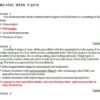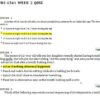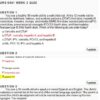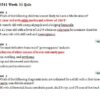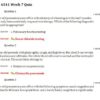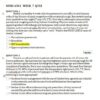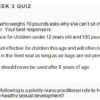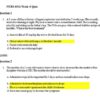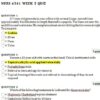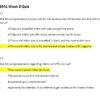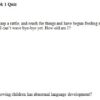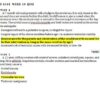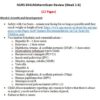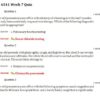Description
NURS 6541 Final Exam 3 – Question and Answers (100/100)
- An 11-year-old has been diagnosed with mild intermittent asthma. Which of the following is not a routine part of the clinical management?
- A 14-year-old has a 3-week history of fever, anorexia, and abdominal pain. What additional symptom would cause the NP to suspect Crohn’s disease?
- A 9-year-old is diagnosed with dyspepsia without hematemesis, melena, or occult blood. The most appropriate next step is
- Jesse, age 5, has a diagnosis of encopresis. After the diagnosis, what would be your next action?
- A 15-year-old girl has experienced abdominal pain, vomiting, and lethargy for 3 days. Her chest and throat examinations are clear, but her abdominal examination is significant for right lower quadrant pain. Rectal examination is equivocal for pain, and her pelvic examination is remarkable for pain upon movement of her cervix. Laboratory data include elevated white blood cell count, serum glucose level of 145 mg/dL, and serum bicarbonate level of 21mEq/dL. Her urinalysis is remarkable for 1+ white blood cells, 1+ glucose, and 1+ ketones. Which of the following is the most likely diagnosis?
- A previously healthy male has a 3-month history of increasing headaches, blurred vision, and personality changes.
- Previously he admitted to marijuana experimentation more than 1 year ago. On examination, he is a healthy, athletic-appearing 17-year-old with a decreased extraocular range of motion and left eye visual acuity. Which of the following is the best next step in his management?
- Kelly, your 11-year-old well visit patient, presents to the office with weight loss, polyuria, and polydipsia. Which of the following do you need to rule out?
- Lisa has Cushing’s syndrome. You would suspect her to have or to develop
- Tracy, the mother of a 2-year-old, is concerned because her daughter walks on her toes all the time. What do you tell her?
- The peak incidence for adolescent gynecomastia occurs at age
- A 12-year-old girl was brought to the emergency department because of severe sore throat, muffled voice, drooling, and fatigue. She had been sick for the past 3 days and is unable to eat because of painful swallowing. The parents deny any history of recurrent pharyngitis. The patient still managed to open her mouth and you were able to see an abscess at the upper pole of the right tonsil with deviation of the uvula toward the midline. Examination of the neck reveals enlarged and tender lymph nodes. Which of the following is the most appropriate management?
- Newborn R.T. has a vascular lesion that will not fade as she gets older. What is your diagnosis?
- A 16-year-old presents with pharyngitis, cough, and high fever. Her chest x-ray reveals bilateral pulmonary infiltrates. Her white blood cell count is normal and the neutrophil count is normal. The most likely etiology is
- A common cause of in-toeing in childhood is
- A 2-year-old presents to your office with the following symptoms: nasal congestion and rhinorrhea for 48 hours, low-grade fever, and a harsh/barky cough that is significantly worse at night. Inspiratory stridor is present and she has clear but slightly decreased breath sounds. Which of the following treatments is best? (NURS 6541 Final Exam)
- All of the following is treatment for a child with phimosis except
- Which of the following is not a feature of DiGeorge syndrome?
- A small-for-gestational-age, dysmorphic newborn infant has microcephaly and sloping forehead, cutis aplasia (missing portion of the skin and hair) of the scalp, polydactyly, microphthalmia, and omphalocele. Which of these is the most likely diagnosis?
- Which-of the following physical stigmata are common in newborns with Down syndrome?
- Which of the following is not associated with congenital adrenal hyperplasia?
- Ana is a 14-year-old female and has not yet started her menstrual cycle. The history is noncontributory and the physical is normal. Mom started her menstrual cycle at 14-years of age. Ana’s breast development and pubic hair began about a year ago. Mom is very concerned. The most appropriate initial step would be to
- An 8-month-old baby arrives to the office with his mother with a complaint of decreased left arm movement. He is a product of a normal term pregnancy, has had no medical problems, and was in good health when his mother dropped him off at the daycare center. Upper arm radiographs show a left humerus spiral fracture. Which of the following is the most appropriate next step in management?
- An ex-preemie with bronchopulmonary dysplasia has been discharged to home from the NICU. One potential problem area that requires close monitoring is (NURS 6541 Final Exam)
- The most common central nervous system side effect of mumps in children is
- A 3-year-old presents with macrocephaly, developmental delay, coarse facial features, large tounge, kyphosis, hip dislocation, tonsillar and adenoidal hypertrophy, and hepatomegaly. She is receiving early intervention services without improvement. What is the best next step?
- Which test is routinely recommended for a preparticipation sports physical?
- A 6-year-old male is brought in for evaluation of a painful hip. He has been limping and not wanting to walk for the past 2 days. He-has no obvious injury. He feels a little better if he is given ibuprofen. He has not had a fever and does not have any other current symptoms, although he had “the flu” last week. On examination, his vital signs are normal. His right hip has some pain with internal rotation. He-walks with a pronounced limp. Which-of the following statements is most accurate?
- Which of the following is true regarding the diagnosis of epiglottitis?
- Which of the following is not characteristic of an apparent life-threatening event (ALTE)?
- Lyme disease is most closely associated with which of the following skin lesions?
- A head injury in which bruising or tearing of the cerebral structures occurs is a
- Which of the following vaccines provides protection against a common type of sepsis/meningitis?
- Which of the following is true regarding innocent murmurs?
- Shelby is a healthy 4-week-old who presents to your office in mid-January with a 3-day history of nasal congestion with occasional cough. She started running a low-grade fever last night (T max 101.5°F). Now she is refusing to nurse and has paroxysmal coughing and noisy/labored breathing. Physical exam reveals an ill-appearing infant with lethargy and tachypnea, intercostal retractions, expiratory wheezes, and occasional rales. She does not attend day care but has a 3-year-old sibling who does and who recently had a “cold.” What is the MOST LIKELY cause of Shelby’s illness? (NURS 6541 Final Exam)
- Individuals with chronic adrenal insufficiency often have
- A 3-year-old presents to your office with a history of wheezing over the last 3 months and has only been moderately responsive to therapy. Which of the following diagnostic tests would be appropriate?
- The most significant major contributor or contributors to asthma morbidity and mortality is/are
- A 3-week-old male infant with 2 days of projectile, nonbilious vomiting and constant feeding. Which of the following is the most likely etiology?
- Dave, age 17, has gynecomastia. You should also assess him for
- Grace, age 15, has been diagnosed with acne. Which of the following is not true with this condition?
- Johnny, age 5, is receiving radiation therapy for his acute lymphocytic leukemia. He is at increased risk of developing which type of cancer as a secondary malignancy when he becomes an adult?
- A 6-year-old boy is left alone for 10 hours, now with hematemesis and pneumomediastinum on chest x-ray. Which of the following is the most likely etiology?
- A 2-year-old boy is brought in with fever and poor feeding. He started getting sick yesterday and has worsened significantly today. He has had no recent illnesses or injuries, and no known ill contacts. On examination, his temperature is 101°F, he is tachycardic, and he appears ill. He is laying on his back with his left leg flexed and abducted at the hip. The HEENT examination is normal, heart is tachycardic but regular, and the lungs are clear. The abdomen is nontender and has normal bowel sounds. He screams in pain when you move his left leg from its resting position. Blood work reveals an elevated WBC count of 15,000 mm3 and an ERS or 45 mm/h. An x-ray of his left hip shows a widened joint space but no fractures. What is your next step at this point?
- When Jason, age 12, slid into homeplate while playing baseball, he injured his ankle. You are trying to differentiate between a strain and a sprain. You know that a sprain
- Primary dysmenorrhea is due to. (NURS 6541 Final Exam)
- The following clinical description best matches which genetic disorder? A tall, thin 14-year-old boy has no signs of puberty. He was delayed in his speech development and always has done less well in school than his siblings. He is shy, and teachers report his activity is immature. Physical examination reveals breast development, and long limbs with a decreased upper segment/lower segment ration. He has small testes and phallus.
- The most common cause of primary amenorrhea is
- Seborrhea dermatitis is common for both infants and adolescents. Which is not correct for this condition?
- You are seeing a patient you think may have IBD. Which of the following tests would not be helpful?
- Mrs. Bay is upset. She is convinced something is seriously wrong with her son. He is a 2-month-old and frequently vomits after feeding. Which of the following is most suggestive of GERD (gastroesophageal reflux disease)?
- Which of the following symptoms are most suggestive of pneumonia in a young child?
- During the 2-year-old well-child visit, the child’s mother shows you a picture from the birthday party. You notice only one eye has a red reflex on the picture. When you do the exam, in the right eye, you notice leukocoria. What is your diagnosis?
- A 3-week old presents to the office in January with a 1-week history of nasal congestion and occasional cough. On the night prior to the visit in infant developed a fever 102ºF rectally, was difficult to breastfeed, and had paroxysmal coughing and noisy, labored breathing. On exam, you note an ill-appearing infant who is lethargic with wheezing, tachypnea, and intercostal retractions. The infant is home with the mom at this time; however, has a sibling who is 4-years-old and is in daycare and recently had cold symptoms. Based on the clinical presentations, what is the most likely cause of the infant’s illness? (NURS 6541 Final Exam)
- A 15-day-old infant has respiratory distress. A quick observation suggests she has slight cyanosis, hepatosplenomegaly, and features consistent with Down Syndrome. The cardiac examination demonstrates a loud first heart sound, a low-pitched, mid-diastolic murmur at the lower left sternal border, and a harsh apical holosystolic murmur in the mitral area. Which of the following cardiac conditions most likely explains her heart findings?
- Which of the following objective data are associated with significantly better long-term outcomes in children born with open spina bifida?
- Unilateral wheezing is a finding suggestive of
- Which of the following is not a sign or symptom of congenital hypothyroidism?
- Sam is a healthy 17-year-old student. He is thinking about having sex and asks for more information about condoms. You give him all of the following information except
- Antibiotic therapy is one of the mainstays of treatment for which of the following causes of wheezing?
- Which of the following patients least warrents a sweat chloride test?
- A healthy 8-month-old infant presents with diarrhea but no dehydration. What is the best advice to give to the parents?
- When examining a child with abdominal pain, what symptom would lead to a likely organic etiology?
- Hope is a 7-month-old who presents in January with a 1-day history of cough, yellow nasal discharge, and low-grade temp (T max 100°F). She was previously healthy. She-does have 2+ edema of the nasal turbinates and cloudy rhinorrhea. She is afebrile in the office. Her chest, mouth, and ears are clear. You prescribe: (NURS 6541 Final Exam)
- Which of the following is not found in an adolescent with untreated Graves’ disease?
- Hypercholesterolemia in children older than 2 is defined as a total cholesterol at or above
- During a track and field meet, a 16-year-old male pole-vaulter falls to the ground screaming in pain. He complains of intense pain in his right scrotum. He-vomits twice while waiting for the ambulance. He most likely has
- In mild to moderate attacks of acute asthma, Albuterol should be given every 4-6 hours prn and routine medication should be
- A common presenting symptom of inflammatory bowel disease is
- A 2-year-old girl has increased work of breathing. Her father notes she had cough and subjective fever over the past 3 days. She has been complaining that her “belly hurts” and has experienced one episode of post-tussive emesis but no diarrhea. Her immunizations are current, and she is otherwise healthy. Her temperature is 102°F. She is somnolent but easily aroused. Respirations are 28 breaths/min, and her examination is remarkable for decreased breath sounds at the left base posteriorly with prominent crackles. Which of the following acute interventions is the LEAST likely to assist in the diagnosis?
- Your patient has inflammatory bowel disease. Which of the following finding is most consistent with ulcerative colitis?
- A 3-week old presents to the office in January with a 1-week history of nasal congestion and occastional cough. On the night prior to the visit in infant developed a fever 102ºF rectally, was difficult to breastfeed, and had paroxysmal coughing and noisy, labored breathing. On exam, you note an ill-appearing infant who is lethergic with wheezing, tachypnea, and intercostal retractions. The infant is home with the mom at this time; however, has a sibling who is 4-years-old and is in daycare and recently had cold symptoms. If the patient has been diagnose with RSV bronchiolitis, which of the following would be the treatment of choice?
- Drew is a 6-month-old with newly diagnose sickle cell disease. His mother brings him to the office for a well-baby visit. Which of the following should you do on this visit?
- The most common presentation of Hirschprung disease is which of the following?
- The most common congenital heart defect in children as
- The organism that causes hand, foot, mouth syndrome is what virus? (NURS 6541 Final Exam)
- In children who have not received antibiotics in the past month, which antibiotic is recommended by the Centers for Disease Control and Prevention for the management of acute bacterial respiratory infection?
- The most common trigger for an acute asthma episode in the very young child is
- Which malignancy is associate with genitourinary anomalies?
- Tommy has bloody diarrhea. His family eats fast-food four to five times each week. Which organism may have caused the diarrhea?
- A 7-month-old female was brought by her mother to an outpatient clinical because of a 2-day history of fever, copious nasal secretions, and wheezing. The mother volunteered that the baby has been healthy and has not had these symptoms in the past. The infant’s temperature is noted to be 100.7°F, her respiratory rate is 50 breaths/min, and her pulse oximetry is 95% on room air. Physical examination reveals no signs of dehydration, but wheezing is hear on lung auscultation. The infant shows no improvement after three treatments with nebulized albuterol. Which of the following is recommend treatment?
- An essential test in the evaluation of a 2-year-old being managed for Kawasaki disease is
- What does shift to the left mean in a white blood count?
- John, age 12, injured his spinal cord by diving into a shallow lake. He is in a wheelchair but can self-transfer. He can use his shoulder and extend his wrist, but has no finger control. At what level of the spinal cord was the damage?
- A 14-year-old girl from another state was follow for 7 years for a history of insulin-dependent diabetes mellitus. Her hemoglobin A1C is 14.9%. This laboratory test indicates which of the following? (NURS 6541 Final Exam)
- A 14-month-old child has lower extremity bowing, a waddling gait, genu varum, and is at the 5th percentile for height. Laboratory data include low-normal serum calcium, moderately low serum phosphate, and elevated serum alkaline phosphatase levels, hyperphosphaturia, and normal parathyroid levels. Which of the following is the most likely diagnosis?
- Which of the following therapeutic options is common for the treatment of both bee stings and bite wounds?
- Mark, age 15, is 5 feet tall andn weighs 85 pounds. You suspect anorexia and know that the best initial approach is to
- An adolescent who has tall stature, increase arm span, laxity of joints, pectus excavatum, and abnormal echocardiogram woudl be expected to have
- The parents of an 8-year-old Down Syndrome boy arrive for his annual well-child visit. He wants to participate in sports, including the Special Olympics. Until further examination can be completed, which of the following sports would you suggest as being safe?
- A 4-year-old female with profuse vomiting, sweating, lacrimation, and diarrhea, who seizes in the emergency room. Which of the following is the most likely etiology?
- Which of the following is the primary diagnostic tool use in the evaluation of seizure disorders?
- What is the primary treatment for testicular torsion?
- Kawasaki disease is most common in
- Which fo the following foods would be most appropriate for a child with celiac disease?
- Six months after being diagnosed with what appears to be insulin-dependent diabetes, the 5-year-old in the case presentation has a significant decrease in his insulin requirement. Which of the following is the most likely explanation?
- Of the following patients, which child should not receive a tuberculin skin test?
- A 10-year-old boy jumps off a 2-foot wall, twisting his foot and ankle upon landing. His ankle x-ray reveals a fracture of the distal tibia over the articular surface into the epiphysis and physis. Based on the Salter-Harris classification for growth plate injuries, you know this as a
- You are examining Beth, age 9 months, and note a palpable right supraclavicular node. You know that this finding is suspicious for
- Prophylactic penicillin should be start in children with sickle cell anemia by. (NURS 6541 Final Exam)
- Jason, age 14, appears with tender discoid breast tissue enlargement (2-3 cm in diameter) beneath the areola. Your next action would be to


